|
|
Canku Ota |
|
|
(Many Paths) |
||
|
An Online Newsletter Celebrating Native America |
||
|
January 11, 2003 - Issue 78 |
||
|
|
||
|
How the Redbird Became Red |
||
|
Cherokee Legend
|
||
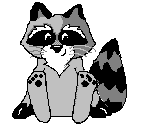 A
long time ago, Raccoon passed Wolf on a path by the creek. As usual,
he insulted Wolf and Wolf began to chase him. Raccoon ran to hide on
a limb of a tree overhanging the creek. Wolf followed, quickly becoming
exhaused. He had been running all day, and was ready for a nap. A
long time ago, Raccoon passed Wolf on a path by the creek. As usual,
he insulted Wolf and Wolf began to chase him. Raccoon ran to hide on
a limb of a tree overhanging the creek. Wolf followed, quickly becoming
exhaused. He had been running all day, and was ready for a nap.
He stopped for a drink from the creek, and when seeing a reflection in the water of Raccoon above him, Wolf dived in. He almost drowned before pulling himself to shore, and he lay on the bank and fell in a deep sleep. Seeing this, Raccon climbed out of the tree, took some clay from the creek bottom and plastered Wolf's eyes shut.
An ugly, brown bird heard the wolf's cries and came to see if he could help. "What happened to you?" asked the little bird. "My eyes have been plastered shut, and I cannot break it off," whinned the wolf. "Can you help me, please?" "I will try," said the bird. As the bird pecked on the clay, it slowly crumbled away and soon Wolf was able to see again. "How can I repay you, brother, for the kindness you have shown?" asked Wolf. "That is not nessesary," replied the bird. But he wolf was so greatful that he wanted to do something. He then looked at the plain, brown bird and said, "I've got it!" He took the bird to where the red rock is found, and using it, painted the little, brown bird red. And so they were, and are today. Print
and Color Your Own Cardinal Here: Listen
to the Cardinal: |
|
|
|
Northern Cardinals
(Cardinalis cardinalis)
|
|
Cardinals are noted for their loud, clear whistled songs, often sung from a high treetop song post. Females will counter sing, duetting with males—usually after the males have established territories and before nesting begins. Local variations and accents have been noted in cardinal songs. Typical habitats are thickets and brushy areas, edges and clearings, riparian woodlands, parks, and residential areas. Here the nonmigratory cardinals feed on a variety of foods including seeds, leaf buds, flowers, berries, and fruit. Up to one-third of its summer diet can be insects. Its winter diet is 90 percent vegetable matter, especially large seeds. Winter flocks can be very large, up to 60 or 70 individuals in areas of abundance.
The female is soft grayish brown on the back with variable areas of red on the tail, crest, and wings. The underparts are a warm pinkish brown. Her coral red bill is also surrounded by darker but not black feathers, so her mask is not as distinct as the male's. Females are slightly smaller than males.
The juveniles are like females but more brown in color, with shorter crest and a blackish bill. They molt to adult plumage in fall. Cardinals have cone shaped bills adapted to eating seeds of all sorts. In the wild, this bird has a varied diet of fruit, seed, and insects. Attract Cardinals to your backyard birdfeeder by offering sunflower seed and cracked corn. Watch as they feed their mates at your feeder, especially during the spring and into the summer. As they offer each other a seed, the pair will touch beaks briefly, almost as if they were gazing longingly into each other's eyes. Also for your Cardinals, plant some shrubs with berries as well as some dense shrubs where they may nest and raise their young.
|
|
|
||
|
|
||
| Canku Ota is a free Newsletter celebrating Native America, its traditions and accomplishments . We do not provide subscriber or visitor names to anyone. Some articles presented in Canku Ota may contain copyright material. We have received appropriate permissions for republishing any articles. Material appearing here is distributed without profit or monetary gain to those who have expressed an interest. This is in accordance with Title 17 U.S.C. section 107. | ||
|
Canku Ota is a copyright © 2000, 2001, 2002, 2003 of Vicki Lockard and Paul Barry. |
||
 |
 |
|
|
The "Canku Ota - A Newsletter Celebrating Native America" web site and its design is the |
||
|
Copyright © 1999, 2000, 2001, 2002, 2003 of Paul C. Barry. |
||
|
All Rights Reserved. |
||
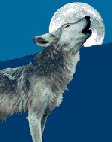 When
Wolf awoke, he could not open his eyes. He scratched at the clay hardened
on his eyes, but could not break it off. He struggled and whinned.
When
Wolf awoke, he could not open his eyes. He scratched at the clay hardened
on his eyes, but could not break it off. He struggled and whinned.  "Now
you are a Redbird," said Wolf, "and all of your children from
this day on will be born with the beautiful, red feathers."
"Now
you are a Redbird," said Wolf, "and all of your children from
this day on will be born with the beautiful, red feathers."  Cardinals,
(Cardinalis cardinalis), are commonly seen in backyards in the eastern
half of the United States. More states have adopted the Northern Cardinal
as their state bird than any other bird. These states are: Illinois,
Indiana, Kentucky, North Carolina, Ohio, Virginia, and West Virginia.
Their range is primarily in the South, East and Midwest, although a
few have been reported in California.
Cardinals,
(Cardinalis cardinalis), are commonly seen in backyards in the eastern
half of the United States. More states have adopted the Northern Cardinal
as their state bird than any other bird. These states are: Illinois,
Indiana, Kentucky, North Carolina, Ohio, Virginia, and West Virginia.
Their range is primarily in the South, East and Midwest, although a
few have been reported in California.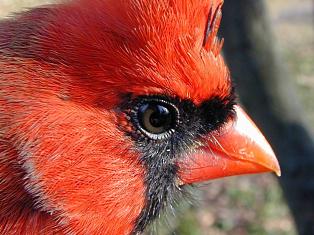 Description:
Northern Cardinals are a medium-sized songbird (approximately 8.75 inches
in length) with short, rounded wings, a long tail, a heavy conical bill,
and a crest. Males are nearly all brilliant red; brownish-gray-tinged
scapular and back feathers give the upper parts a less colorful appearance.
The coral red bill is surrounded by a mask of black that extends to
a dark eye and includes the chin and throat. Legs and feet are dark
red.
Description:
Northern Cardinals are a medium-sized songbird (approximately 8.75 inches
in length) with short, rounded wings, a long tail, a heavy conical bill,
and a crest. Males are nearly all brilliant red; brownish-gray-tinged
scapular and back feathers give the upper parts a less colorful appearance.
The coral red bill is surrounded by a mask of black that extends to
a dark eye and includes the chin and throat. Legs and feet are dark
red.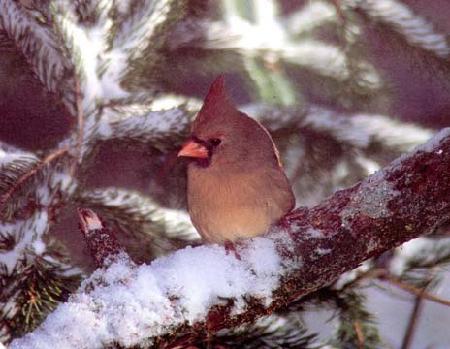 Cardinals
mate for life. If you see one, look closely into the trees, bushes,
or brush for the other. They prefer a dense area, such as a thicket
or thickly branched tree to make their nest of twigs and grass. Mom
will lay 3 - 5 eggs and incubate them, while Dad will bring her food.
When the young Cardinals can fly, Dad may watch over them while Mom
may begin a second brood.
Cardinals
mate for life. If you see one, look closely into the trees, bushes,
or brush for the other. They prefer a dense area, such as a thicket
or thickly branched tree to make their nest of twigs and grass. Mom
will lay 3 - 5 eggs and incubate them, while Dad will bring her food.
When the young Cardinals can fly, Dad may watch over them while Mom
may begin a second brood.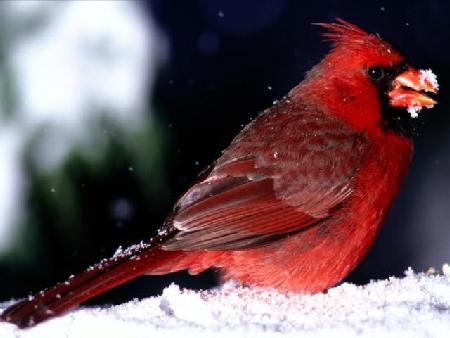 Cool
fact: In the 1800s Cardinals were much-sought-after cage birds highly
valued for their color and song. Thousands were trapped in the south
in the winter and sent to northern markets, and thousands more were
sent to Europe. This trade ceased, fortunately, with the passage of
the Migratory Bird Treaty Act of 1918.
Cool
fact: In the 1800s Cardinals were much-sought-after cage birds highly
valued for their color and song. Thousands were trapped in the south
in the winter and sent to northern markets, and thousands more were
sent to Europe. This trade ceased, fortunately, with the passage of
the Migratory Bird Treaty Act of 1918.